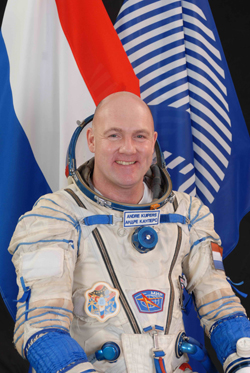RSC
Energia bio
(Apr 09) |
 Andre
KUIPERS Andre
KUIPERS
ISS Flight Engineer,
Soyuz ÒÌÀ TSC Flight Engineer,
ESA Astronaut, The Netherlands
DATE AND PLACE OF BIRTH:
October 5, 1958, Amsterdam, The Netherlands.
EDUCATION: In 1977, Andre Kuipers graduated from Van der Waals Lyceum,
Amsterdam. Received a Medical Doctor degree from the University of Amsterdam
in 1987.
FAMILY STATUS: married, has two daughters.
ORGANIZATIONS: Member of the Aerospace Medical Association, the Dutch
Aviation Medicine Society and the Dutch Association for Spaceflight.
AWARDS: Officer of the Order of Orange-Nassau.
HOBBY: Flying, scuba diving, skiing, hiking, travelling and history.
WORK EXPERIENCE:
During his medical studies, Andre' Kuipers worked in the Vestibular
Department of the Academic Medical Center in Amsterdam, the Netherlands,
where he was involved in research of human equilibrium system.
In 1987-1988, as an officer of the Royal Netherlands Air Force Medical
Corps, he studied accidents and incidents caused by spatial disorientation
of pilots.
In 1989-1990, he worked for the Research and Development Department
of the Netherlands Aerospace Medical Center in Soesterberg. He was involved
in research of the astronauts adaptation in space, contact lenses for pilots,
vestibular apparatus, blood pressure and cerebral blood flow. In addition,
he performed medical examinations of pilots and medical monitoring of human
centrifuge training, and also gave lessons to pilots in psychological aspects
of flying.
Since 1991, Kuipers has been involved in preparation, coordination,
baseline data collection and ground control of psychological experiments
developed by the European Space Agency. In particular, he was a Project
Scientist for a human physiology facility that flew on the D2 Spacelab
mission in 1993, and for two payloads, for lung and bone physiology, that
flew aboard the Mir Space Station during the six-month Euromir-95 mission.
He was involved in the development of the Torque Velocity Dynamometer (TVD)
that flew on the LMS Spacelab mission in 1996, the Muscle Atrophy Research
and Exercise System (MARES), a special device used in muscle research onboard
the Space Station, and an electronic muscle stimulator (PEMS).
Andre Kuipers provided support to the life science experiments during
the ESA parabolic flight campaigns which are performed twice a year. He
participated in these flights as an experiment operator, technician, test
subject and flight surgeon.
In July 1999, Andre Kuipers joined the European Astronaut Corps of
the European Space Agency, whose homebase is at the European Astronaut
Center (ÅÀÑ) in Cologne, Germany.
Concurrently with his training he was assigned to the European Space
Research and Technology Center (ESTEC), Noordwijk, the Netherlands, continuing
his former work for the Microgravity Payloads Division within the Directorate
of Human Spaceflight. Until the start of preparations for his flight to
the ISS, Andre Kuipers supported an active research program in the field
of psychological adaptation of humans to weightlessness, coordinated the
European experiments on lung function and blood pressure regulation, which
will be performed using ESA's specially developed apparatus, the Advanced
Respiratory Monitoring System (ARMS).
In 2002, Andre Kuipers completed ESA's Basic Training Program which
was performed at the European Astronaut Center (ÅÀÑ)
in Cologne, Germany, and Yu.A. Gagarin Cosmonaut Training Center, Star
City, Russia.
From October 30 to November 10, 2002 as 'Cap Com' during implementation
of the Odissea Project onboard the ISS by Belgian ESA astronaut Frank De
Winne (VC-4), Andre Kuipers supported ESA's ground team at the Russian
Mission Control Center. He passed training for a spaceflight as a flight
engineer within the Expedition a backup crew (VC-5).
In December 2002 he was assigned as a Flight Engineer of the Soyuz
ÒÌÀ spacecraft for a flight to the International Space
Station (ISS) within the visiting crew (VC-6) in April 2004.
In July 2003 he was assigned as a Flight Engineer for the prime crew
of the Soyuz ÒÌÀ-4 spacecraft.
He performed his first spaceflight on April 19 - 30, 2004 onboard the
Soyuz ÒÌÀ-4 spacecraft, together with Gennady Padalka
(commander) and Michael Fincke (flight engineer-2) within the crew of Expedition
9 to the ISS. Since April 21 he worked onboard the ISS under the European
program.
Andre Kuipers landed in the Soyuz ÒÌÀ-3 spacecraft,
together with the crew of Expedition 8, namely A. Kaleri and Michael Foale.
The flight duration was 10 days 20 hours 48 min 46 s.
At a period of January 16 - 27, 2007 he participated in the training
for survival within the preliminary crew, together with Oleg Kononenko
(Russia) and Robert Thirsk (Canada), in the forest 30 km from Moscow.
In August 2007 he was preliminarily assigned to the backup crew of
Expedition 20 to the ISS (ISS-20). On February 12, 2008 NASA officially
declared on his assignment to the backup crew.
On June 22 - 28, 2008 in Sevastopol, the Ukraine he participated in
the training within the preliminary crew, together with Maxim Ponomarenko
(Russia) and Chris Hadfield (Canada) in case of the descent vehicle water
landing.
April 2009
By the data of ESA sites and www.astronaut.ru |
|




 Andre
KUIPERS
Andre
KUIPERS
 Andre
KUIPERS
Andre
KUIPERS